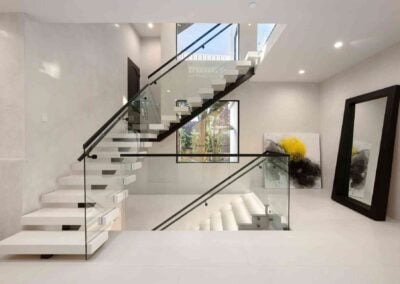When choosing new windows for your home, even small design details can have a big impact on comfort, efficiency, and long-term value. Two of the most common and trusted styles are single-hung and double-hung windows. While they look similar at first glance, their operation, ventilation, and maintenance differ in ways that can influence your daily experience.
Understanding these differences is key to choosing single and double-hung windows that align with your home’s design, energy-saving goals, and long-term maintenance preferences. This guide provides the information you need for an informed choice, explaining how each window style works, outlining its benefits and disadvantages, comparing costs, and helping you determine which performs best for lasting comfort, efficiency, and value.
Table of Contents
What Are Single-Hung and Double-Hung Windows?
Single-hung and double-hung windows share a similar appearance, but their function and versatility differ in important ways. Both remain among the most popular window styles for modern and traditional homes because they combine timeless design with reliable performance.
Single-Hung Windows
Single-hung windows feature one fixed window sash on top and an operable sash on the bottom. The lower sash can slide open, allowing fresh air to enter while keeping the top section stationary. This simple design offers dependable performance at a lower cost, making it a practical option for homeowners seeking quality and value.
Double-Hung Windows
What is a Double-Hung Window?
Double-hung windows include two sashes that move independently. You can open the bottom sash to let in cool air or the top sash to release warm air, improving airflow throughout the room. This dual movement also makes cleaning easier, especially in multi-story homes, where the sashes can tilt inward for convenient access.
Single-Hung vs Double-Hung Windows: Key Differences at a Glance
While single-hung and double-hung windows look nearly identical, their function, maintenance, and versatility differ in meaningful ways. The comparison below highlights how each performs in areas that matter most to homeowners, including operation, ventilation control, cleaning, cost, and efficiency.
|
Feature |
Which Is Best? |
Why It Matters |
|
Operation |
Both |
Both styles are easy to use; double-hung offers more flexibility, while single-hung offers simplicity. |
|
Ventilation |
Double-hung |
The two movable sashes are the standout double-hung window feature, providing superior airflow and temperature control. |
|
Cleaning and maintenance |
Double-hung |
Tilting sashes make both sides easy to clean from indoors. |
|
Cost |
Single-hung |
Fewer moving parts make them more affordable to purchase and install. |
|
Energy efficiency |
Single-hung |
Fewer seams reduce the chance of air leaks, enhancing insulation. |
|
Safety |
Double-hung |
Opening the upper sash allows fresh air in while keeping children and pets safe. |
|
Ease of operation |
Single-hung |
Simple, lightweight design with one sash that moves smoothly. |
|
Design flexibility |
Double-hung |
Available in more styles, colors, and grid patterns to match various home designs. |
|
Maintenance |
Single-hung |
Fewer moving parts mean fewer repairs and long-term durability. |
|
Installation |
Single-hung |
Faster and easier to install due to simpler construction. |
|
Long-term value |
Double-hung |
Higher resale appeal and versatility justify the added cost for many homeowners. |
|
Best for |
It depends |
Single-hung suits budget-focused or ground-floor installs; double-hung is ideal for multi-story homes or rooms needing airflow. |
Operation
Both single-hung and double-hung windows are easy to operate, so this category is essentially a tie. In a single-hung window, only the bottom sash opens and closes while the upper sash remains stationary. This straightforward design keeps operation simple and dependable. Each sash moves smoothly along vertical tracks, providing effortless use for everyday ventilation.
Ventilation
Double-hung windows win when it comes to ventilation. Because both the upper and lower sashes can open, hot air escapes naturally through the top while cool air flows in from the bottom, creating balanced circulation throughout the room. This design provides maximum ventilation, allowing you to better regulate indoor temperature and maintain fresh air year-round. Single-hung windows, with only one movable sash, still provide adequate airflow but can’t match the same level of control or balance offered by double-hung models.
Cleaning and Maintenance
Double-hung windows are the clear winner here. Their tilt-in sashes and tilt latches make it easy to clean both interior and exterior surfaces from inside your home, an important advantage for upper floors or hard-to-reach areas. Single-hung windows are simpler mechanically, which means less can go wrong, and they remain one of the best low-maintenance options for homeowners who prefer minimal upkeep. However, their fixed upper sash makes exterior cleaning more challenging, especially on multi-story homes.
Cost
Single-hung windows take the lead for affordability, requiring fewer materials and less labor to manufacture and install, keeping prices lower overall. This simple design makes them a cost-effective choice for homeowners focused on long-term value. Double-hung windows typically cost more upfront, reflecting the cost difference associated with their added functionality, dual operation, and ease of maintenance.
Energy Efficiency
Single-hung designs are considered the more energy-efficient option because their fixed upper sash creates a tighter seal that helps prevent air infiltration. This improved insulation stabilizes indoor temperatures and can reduce heating and cooling demands, lowering monthly utility bills. Double-hung windows can also perform efficiently when built with quality materials, insulated glass, and proper weatherstripping. However, their additional moving sash introduces more seams that may allow minor air transfer over time if not properly maintained.
Safety
Double-hung windows are safer for households with children or pets because you can open the operable top sash while keeping the lower sash closed. This setup allows for ventilation without creating a fall risk. Unlike single-hung windows, which only open from the bottom, double-hung styles give homeowners more flexibility to maintain airflow while keeping living spaces secure.
Ease of Operation
Single-hung windows win for straightforward operation. The single sash moves smoothly along its track, making it lightweight and simple to lift or close. Double-hung windows function similarly but include two movable sashes. These double sash windows can feel slightly heavier due to their added components, which may require a bit more effort to open and close.
Design Flexibility
Double-hung windows come out ahead in design variety. Manufacturers offer a wider range of frame styles, grille patterns, and color finishes, making it easier to match them with different architectural looks and traditional home styles. Single-hung windows have a more classic appearance and fewer customization options, but still provide timeless appeal for colonial or craftsman-style homes. Both styles are available in custom sizes, allowing homeowners to tailor their windows to fit unique openings or design preferences.
Maintenance Over Time
Single-hung windows require less upkeep overall. With fewer parts that move or tilt, there’s less hardware to maintain or replace, making them one of the best low-maintenance options for busy homeowners. Double-hung windows are built for long-term durability but require periodic cleaning and lubrication of tracks and locks to ensure smooth performance. Both styles are available in durable materials like vinyl and fiberglass window frames, which resist warping, rotting, and corrosion over time.
Installation
Single-hung windows are simpler and faster to install, saving time and labor costs. Their fixed upper sash makes them easier to align and seal properly within the window frames. Double-hung windows take longer to install due to their dual operation system, but experienced installers can still complete the process efficiently.
Long-Term Value
Double-hung windows have an edge in long-term value. Their ventilation flexibility, easy cleaning, and widespread popularity make them a smart investment. Because most double-hung windows enhance both comfort and curb appeal, they tend to increase home resale value. Single-hung windows provide excellent durability and insulation, appealing to homeowners prioritizing simplicity and efficiency.
Best For
Single-hung windows are best suited for first floors, basements, and areas where windows are easy to reach from outside. Double-hung windows are ideal for two-story homes, bedrooms, and living areas where extra ventilation and easy cleaning are priorities.

Schedule a Free Consultation
Get a free home window inspection, talk with one of our design consultants to get product recommendations, and learn about special offers and financing.
Benefits of Single- and Double-Hung Window Styles
Each window type offers distinct advantages depending on what matters most to you: cost, convenience, ventilation, or long-term value. Single-hung windows focus on simplicity and affordability, while double-hung windows emphasize versatility, safety, and ease of use. The table below outlines the key benefits of each style to help you decide which option best fits your home.
|
Single-Hung Windows |
Double-Hung Windows |
|
Lower upfront cost: A simpler design with one movable sash keeps material and installation costs low without compromising quality. |
Better ventilation and airflow: Two operable sashes allow warm air to escape from the top and cool air to enter from the bottom for balanced circulation. |
|
Simple operation and maintenance: Fewer moving parts make single-hung windows easy to operate and maintain over time. |
Easier cleaning with tilt-in sashes: Both sashes tilt inward, making it easy to clean interior and exterior glass from inside your home. |
|
Reliable energy efficiency: The fixed upper sash reduces air leakage and helps maintain indoor temperatures year-round. |
Safer with upper sash opening: Opening only the top sash provides ventilation while keeping lower openings secure for families with young children or pets. |
|
Traditional, timeless appearance: A classic design that suits traditional and colonial-style homes while maintaining curb appeal. |
Ideal for upper-floor applications: The tilt-in design and flexible operation make double-hung windows convenient for second stories or hard-to-reach areas. |
|
Long-term durability: With fewer mechanical parts to maintain, single-hung windows often last longer with minimal upkeep. |
Greater flexibility in daily use: Two independently moving sashes provide more control over airflow, comfort, and temperature throughout the home. |
|
Customization options: Available in various materials and finishes to match most home styles, though fewer than double-hung options. |
Broader customization choices: Offered in more frame styles, grille patterns, and color combinations to complement both modern and traditional homes. |
|
Resale value: A practical and efficient upgrade that appeals to buyers seeking reliability and energy savings. |
Higher resale appeal: Double-hung windows are a sought-after feature for their versatility, safety, and easy maintenance. |
Disadvantages of Single- and Double-Hung Window Styles
While both single-hung and double-hung windows perform well, each comes with certain trade-offs. Understanding these drawbacks can help you make a confident, well-informed decision based on your home’s design, maintenance preferences, and long-term goals. The table below outlines the main disadvantages of each window style and how they compare.
|
Single-Hung Windows |
Double-Hung Windows |
|
Limited ventilation: Only the lower sash opens, restricting airflow and reducing temperature control. |
Higher upfront cost: The dual-sash design increases material and installation expenses. |
|
Challenging exterior cleaning: The fixed upper sash makes cleaning the outside surface difficult, especially on upper floors. |
More mechanical components: Additional moving parts increase the likelihood of wear and the need for occasional repairs. |
|
Less design flexibility: Available in fewer styles, finishes, and configurations than double-hung windows. |
Slightly reduced energy efficiency: More seams and movable parts can create minor opportunities for air leakage over time. |
|
Restricted accessibility: Harder to clean and operate when installed in tall or hard-to-reach openings. |
More complex installation process: Dual-sash mechanisms require extra care during installation to ensure proper alignment and sealing. |
|
Lower resale appeal: Viewed as a budget-friendly option that may not attract buyers looking for premium features. |
More frequent maintenance: Tracks and locks need periodic cleaning and lubrication to maintain smooth performance. |
Single- vs Double-Hung Window Costs
When it comes to replacement windows, cost is often the first factor homeowners consider. While both single-hung and double-hung windows deliver strong performance, their price differences largely stem from the number of moving parts, the materials chosen, and the complexity of the installation.
On average, double-hung windows cost about 10 to 20% more than single-hung windows of the same size and material, reflecting their added functionality and ease of maintenance. In most cases, single-hung windows range from $100 to $400 per unit, while double-hung windows range from $150 to $650 per unit, depending on size, material, and energy-efficient upgrades. Though they come with a higher upfront price, double-hung models often deliver greater long-term value through improved functionality, safety, and comfort.
Choosing the Right Window Styles for Your Home
Every home and room has different needs. Whether you’re focusing on ventilation, maintenance, design, or budget, understanding when to choose single-hung vs double-hung windows can help you make the most of your investment. Use this guide to match your goals with the window style that fits best.
|
What You Want for Your Home |
Best Window Style |
|
“I’m replacing windows on a tight budget.” |
Single-hung windows |
|
“I want easy access for cleaning on upper floors.” |
Double-hung windows |
|
“I prefer a window that requires minimal maintenance.” |
Single-hung windows |
|
“I want better airflow and control over ventilation.” |
Double-hung windows |
|
“I’m updating a ground-floor or basement room.” |
Single-hung windows |
|
“I need safe ventilation for rooms where children play.” |
Double-hung windows |
|
“I want a simple, classic look for my home’s exterior.” |
Single-hung windows |
|
“I live in a multi-story home.” |
Double-hung windows |
|
“I’m looking for the most energy-efficient option.” |
Single-hung windows |
|
“I want a window that adds resale appeal and convenience.” |
Double-hung windows |
|
“I’m installing windows in hard-to-reach areas.” |
Single-hung windows |
|
“I want flexibility to adjust airflow throughout the day.” |
Double-hung windows |
Find the Best Windows for Your Home
Choosing between single-hung and double-hung windows ultimately comes down to your home’s design, your budget, and how you use each space. The right style will balance comfort, ventilation, and long-term value, giving you years of dependable performance and visual appeal.
If you live in the Seattle area, schedule a complimentary in-home consultation with Lake Washington Windows & Doors. Our window experts will guide you through design options, energy-efficient upgrades, and pricing to help you find the perfect fit for your home.















